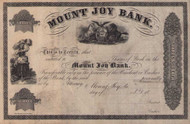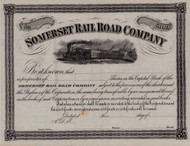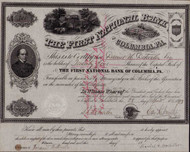Categories
Categories
- Home
- Banking and Money
- Banks
- Thomaston National Bank stock certificate circa 1928 (Maine)
Thomaston National Bank stock certificate circa 1928 (Maine)
Product Description
Thomaston National Bank stock certificate circa 1928 (Maine)
Maine bank stock certificate collectible! Great vignette of the state seal of Maine. Very clean. Unissued and not cancelled. Circa 1928 from issued examples. Measures approximately 10.5 x 6.75 inches.
The bank had various share versions issued over the years (from other known examples from this bank) but these were apparently the last ever printed due to the sale in 1931. The Thomaston Bank was organized in 1825 and remained in business until becoming the Thomaston National Bank in 1865.
The Thomaston National Bank in Maine, established as a state bank in 1825 and a national bank in 1865, was the oldest bank in Knox County before being sold to Financial Institutions Inc. Financial Institutions, Inc. was a Maine-based corporation that owned the stock of multiple Maine banks, with over 85% of its common stock owned by Maine capital.
Thomaston, formerly known as Fort St. Georges, Fort Wharf, and Lincoln, is a town in Knox County, Maine, United States. The population was 2,739 at the 2020 census. Noted for its antique architecture, Thomaston is an old port popular with tourists. The town was named after Major General John Thomas.
As early as 1630, a trading post was established on the eastern bank of the St. George River, then considered the boundary between New England and New France. In 1704, Thomas LeFebvre from Quebec bought a large tract of land along the Weskeag River on which he built a gristmill, with a house on the shoreline at what is now South Thomaston. The area became known as Thomas' Town. In 1719–1720, the old trading post was remodeled into Fort St. George, a stockaded fort protected by two blockhouses. But Abenaki Indian tribes protested the encroachment of an English fort on their territory. Instigated by the French, they attacked the garrison twice during Dummer's War in 1722, then again in 1723 with a siege lasting 30 days. In response to this and other provocations, soldiers destroyed the Abenaki stronghold of Norridgewock in 1724.
During the French and Indian War, to avenge the fall of Louisbourg, on August 13, 1758, French officer Boishebert left Miramichi, New Brunswick with 400 soldiers for Fort St. George in Thomaston. His detachment reached there on September 9 but was caught in an ambush and had to withdraw. This was Boishébert's last Acadian expedition. They then went on to raid Friendship, Maine, where people were killed and others taken prisoner. Hostilities of the French and Indian Wars ceased with the 1759 Fall of Quebec. Mason Wheaton was the first permanent settler in 1763. Located at the heart of the Waldo Patent, Thomaston was incorporated from St. Georges Plantation on March 20, 1777. Many settlers arrived following the Revolutionary War in 1783. General Henry Knox built his Montpelier mansion at Thomaston in 1793–1794.
The town prospered in the early 19th century as a port and ship building center. Around 1840, two of seven recorded millionaires in the United States were Thomaston sea captains. Other industries included two gristmills, two sawmills and planing mills, three sail lofts, brickyards, cask manufacturing and a marble works. Lime had been manufactured here since 1734 in kilns. Thomaston is still home to Jeff's Marine, Inc. and Lyman Morse Boatbuilding, builders of custom power and sailing yachts. Located on St. George River, Lyman Morse Boatbuilding sits on the original site of the General Henry Knox Mansion, where wooden schooners have been built for over 200 years.
Thomaston was home to the Maine State Prison until 2002, when it moved to Warren and the former facility was demolished. The prison was locally famous for its shop featuring handmade wares of prisoners and inspired the prison in the film, The Shawshank Redemption.
Product descriptions and images
Please note that some pictures may only be representative of the inventory available. If we have more than one piece, we are unable to scan and display every piece. Unless otherwise noted, that there are variations for signatures, cancellation marks/holes, serial number, and dates. Colors will be as noted and pictured.
 Loading... Please wait...
Loading... Please wait... 







